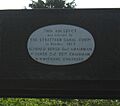Wootton Wawen Aqueduct facts for kids
Have you ever seen a bridge that carries water instead of cars or people? That's exactly what an aqueduct does! The Wootton Wawen Aqueduct is a special kind of water bridge. It helps boats on the Stratford-upon-Avon Canal cross over a main road.
This amazing structure is one of three aqueducts found along a 6-kilometer (about 3.7 miles) stretch of the canal in Warwickshire, England. What makes these aqueducts extra unique is how they are built. Their towpaths, which are paths for people to walk alongside the canal, are at the same level as the bottom of the canal itself.
Contents
Wootton Wawen Aqueduct: A Water Bridge
The Wootton Wawen Aqueduct is a fantastic example of old engineering. It allows boats to travel smoothly over land obstacles. This particular aqueduct is located just outside the village of Wootton Wawen. It carries the canal over the busy A3400 main road.
What is an Aqueduct?
An aqueduct is like a bridge, but instead of carrying a road or railway, it carries water. In the case of canals, a "navigable aqueduct" means it carries a waterway that boats can use. Imagine a river flowing high above the ground! That's what an aqueduct does for a canal.
Aqueducts have been built for thousands of years. Ancient Romans used them to bring fresh water to their cities. Canal aqueducts, like the one at Wootton Wawen, became important during the Industrial Revolution. They helped connect different parts of the country by water.
Where is Wootton Wawen Aqueduct?
This historic aqueduct is found in the beautiful county of Warwickshire in England. It's a key part of the Stratford-upon-Avon Canal. This canal was built to connect the town of Stratford-upon-Avon, famous for William Shakespeare, with the wider canal network.
The aqueduct is a landmark near the village of Wootton Wawen. It helps the canal avoid a steep hill and cross the main road below. This clever design means boats don't have to go up and down locks just to get past the road.
How Was It Built?
The Wootton Wawen Aqueduct was built a long time ago, in 1813. It was constructed by the Stratford Canal Company. This company was responsible for building the entire canal. Building such a structure over 200 years ago was a huge challenge!
The aqueduct is made from cast iron. This was a strong and popular material for building during the Industrial Revolution. Cast iron is made by melting iron and pouring it into molds. This allowed engineers to create large, sturdy sections for the aqueduct's trough, which holds the water.
Why is it Special?
The Wootton Wawen Aqueduct is considered a very important historical structure. It has a special status called "Grade II* listed." This means it's a building of more than special interest. It's protected because of its history and unique design.
One of its most unusual features, shared with the other two aqueducts on this part of the canal, is how the towpaths are built. Instead of being above the water level, they are at the same level as the canal bottom. This design is quite rare and makes these aqueducts stand out. It shows the clever thinking of the engineers who designed them so long ago.
Images for kids



